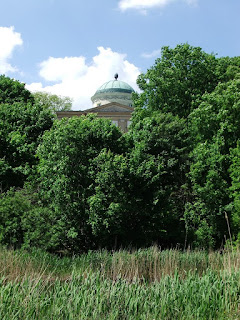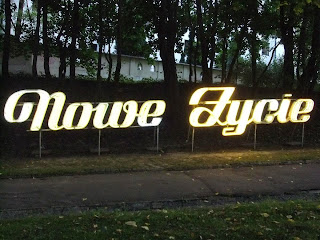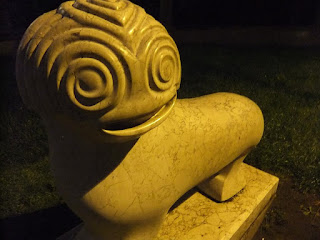It's one of my favourite Warsaw places.

The palace of Królikarnia was built in 1780s for an ex soldier, Italian of origin and now on the Polish soil: a count, gambler and oportunist who made his career close to the Polish court.
The title of count was bestowed on him by the Polish king, who was apprently easily impressed - the king was a great admirer of Italy and its art - might this have been enough to invite Carol Thomatis to the court and make him a director of the national theatre? apparenty Thomatis did display some sophistication and taste in culture, but soon he showed also his greed and cunnigness. He wasn't sent to exile, though, neither was he punished; instead he continued to live in and make fortune in Poland.

He was a nouveau riche among aristocracy and he aspired to be counted as was of them. Building a reprsentative residence on the Vistula embankment, which was already inhabited by other aristocrats, was surely an investment in prestige. Especially that he decided to hire a court architect for this job - Dominico Merlini, another Italian working for the king.
Merlini found his inspiration in Italy and likened the palace to the ideal Renaissance villa - Villa Rotonda in Vicenca.
Obviously the Polish version was less symetrical and smaller than the inspiration, yet it is counted as a descendant of Palladio's idea.
The palace and its surroundings was also an investiment from the mundane, practical point of view. After all before the palace was built first auxiliary buildings, like stables, mills etc, were erected.
Those included the kitchen, which was built on the slope of the valley and which is one of the characteristics of the palace complex.
This building, for a change, was likened to.. a tomb. To be more precise to mausoloem of Cecilia, which is still to be found in Rome in Via Appa.

the genius of Merlini made him build the kitchen in the gorge - thus the gorgeous building was well exposed and at the same time it didn't hinder to admire the heart of the complex where its host resided and entertained his guests - the palace .
Now it's best to admimre both in the winter, if you want to have look from the foot of the hill. now it's the lush greenery that protects the palace....
Let's make a leap in time and slightly in space. Let's enter from Puławska street.
The Królikarnia palace houses now a branch of the National Museum and it's mostly devoted to sculpture. After the war it was meant to become a studio and a living place of an renowned Polish sculptor Xawery Dunikowski, but the reconstruction of the palace took so long that the already elderly artist didn't make it to see the realisation of this plan. The project was realised only partially and the palace and its park are now an exhibition of his art...

...and not only his... and not only scultpures...
.
An example from recent years: "nieużytki sztuki" - "wasteland of art" - a possibility to rent a plant-pot.... and cutivate flowers or vegetables.
I think this initiative has been somewhat abanodned by now.
The beehives on the slope just below th palace are a permanent part of Króliarnia now.
The surroundings are also frequented by petanque players...
Neons - one of exhibitions from a few years back.
And below the palace complex: a natural parc with streams oozing here and there, creating a special microclimat... not so far away from the city centre!


























Brak komentarzy:
Prześlij komentarz